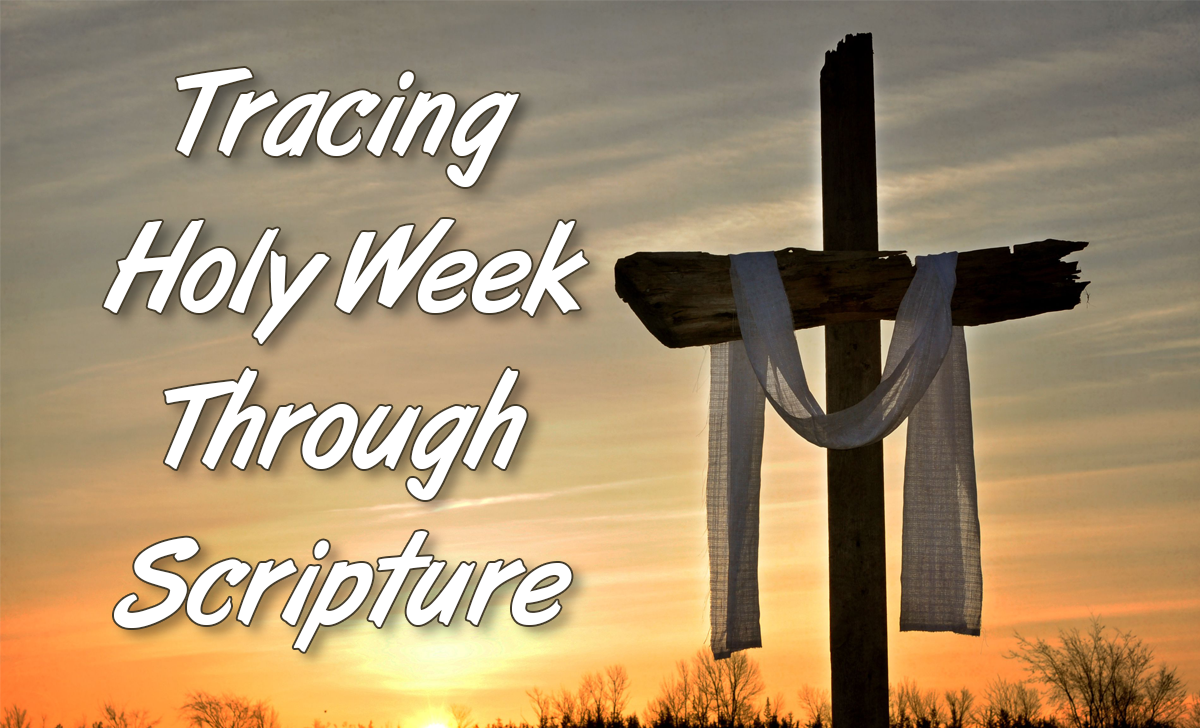
The Tracing Holy Week Through Scripture document has been prepared as a tool to help you read the Bible’s account of the events of Holy Week. Of course, there have been some assumptions regarding which events took place on which day; not all scholars are in agreement. To keep you aware of this, there are occasional notes and comments along the way. As you and your family read the passages according to the days of the week, know that you’ll be tracing Holy Week day by day using only the words of Scripture.
Have you ever read all of the passages in Scripture that describe Jesus’ last week in Jerusalem before His death and resurrection? Holy Week is an excellent opportunity to do just that.
A biblical chronology of Jesus’ last week can only be approximate. The gospels were written by the Holy Spirit through four different individuals highlighting different aspects of the life and ministry of Jesus, organizing their information in different ways. It would appear that the Holy Spirit did not see fit to present us with a moment-by-moment biography of the life of Jesus. Some of the difficulties of harmonizing from the accounts of Matthew, Mark, Luke, and John this single week are pretty challenging.
Just as an example, it’s difficult to discern exactly when Judas conspired with the Sanhedrin, or the timing of the anointing at Bethany (in Matthew 26.6-13 and Mark 14.3-9), or if John 18.28-40 recounts Jesus’ first or second trial before Pilate, or to what event John 14.31b refers to when Jesus says, “Rise, let us go from here.”. Adding to the complexity, the duration of the Jewish trial and Peter’s denial, the timing of Jesus’ evenings in Bethany, and other events are simply hard to place. Finally, we should add that the Jewish reckoning of the start of a new day at sunset rather than midnight, makes the translation to our own calendar rather imprecise.
Despite these and other challenges, the following has been prepared as a tool to help you read the Bible’s account of the events of Holy Week. Of course, there have been some assumptions regarding which events took place on which day; not all scholars are in agreement. To keep you aware of this, there are occasional notes and comments along the way. As you and your family read the passages according to the days of the week, know that you’ll be tracing Holy Week day by day, using only the words of Scripture.
The 43-page document, “Tracing Holy Week Through Scripture,” includes all of the ESV Scriptures that describe Holy Week, arranged according to each day of the week. Immediately below you’ll find just the Scripture references.
Unlike a devotional where the daily readings are the same length, you’ll notice some of the readings are short (like Wednesday), while some are very long (Tuesday and Thursday). You’ll probably want to adjust your reading, somewhat, if you’ll be reading aloud for family devotions. You’ll also notice all of the repetition has been saved; you read one gospel account after the next.
The important objective is to gain a richer sense of how the very words of Holy Scripture teach us about this week leading up to the death and resurrection of Jesus.
Download “Tracing Holy Week Through Scripture”
Saturday evening
Jesus arrives in Bethany, on the eastern side of the Mount of Olives, to stay with friends (Lazarus, Mary, and Martha) where He has dinner and is anointed by Mary. John 12.1-8; Mark 14.3-9; Matthew 26.6-13
Soon, a very crowd gathers. John 12.9-11
Sunday (early in the day)
The disciples, instructed by Jesus, make preparation for His entry into Jerusalem. Matthew 21.1-6; Mark 11.1-6; Luke 19.28-34
Jesus enters Jerusalem, an event that has come to be known in the history of the church as His Triumphal Entry. Matthew 21.7-11; Mark 11.7-10; Luke 19.35-40; John 12.12-19
Jesus weeps over Jerusalem (it seems He will do so, again, on Tuesday afternoon). Luke 19.41-44
Some Gentile God-fearers, in Jerusalem for the Passover celebration, learn of His arrival and desire to meet with Him. John 12.20-36a
Sunday (evening)
Jesus enters the Temple court itself, but it is hard to know for how long He stayed. Mark 11.11a
He and His disciples depart Jerusalem, likely for Bethany, and perhaps taught along the way. Matthew 21.17; Mark 11.11b; John 12.36b-50
Monday morning
According to Mark, the event of cursing the fig tree likely occurred in two stages, on Monday and again on Tuesday morning. Matthew seems to compress this two-day event. Matthew 21.18-19; Mark 11.12-14
Jesus clears the Temple court of its commercial atmosphere. Though Matthew places this scene immediately upon His arrival in Jerusalem, Mark’s account seems to indicate that it occurred Monday morning. Mark 11.15-18; Matthew 21.12-13; Luke 19.45-46
Monday afternoon
Jesus departs Jerusalem to Bethany for the night. Mark 11.19
Tuesday morning
The lesson of the fig tree, continued. Mark 11.20-25 [26]; Matthew 21.20-22
Tuesday afternoon
Jesus teaches at great length in the Temple court, largely concerning His own authority and judgment upon the religious leaders for discouraging the people from worshipping Him. You may wish to save a portion of this reading for Wednesday. Matthew 21.23-22.45; Mark 11.27-12.44; Luke 20.1-21.4
The following seven woes likely occurred as interspersed pronouncements in Jesus’ Tuesday afternoon teaching (as you have already seen hints of in Mark and Luke above), but Matthew gathers all of them together with great force. Matthew 23.1-36
Jesus departs from the Temple area of the city. Matthew 24.1-2; Mark 13.1-2; Luke 21.5-6
Like Sunday evening, Jesus, again, weeps for Jerusalem (by the way, if you look at Luke 13.34-35 you’ll see another occasion in which He did this). Matthew 23.37-39
Tuesday evening
Jesus teaches His disciples (at length) on the Mount of Olives, a small incline a half-mile east of Jerusalem. In the Kidron Valley between was a seasonal brook, likely full at the time. With a spectacular view of the Temple, Jesus delivers a prophetic overview to His disciples of the near and distant future. Due to the location, this challenging text is often called the Olivet Discourse. Luke 21.7-36; Matthew 24.3-25.46; Mark 13.3-37
Wednesday morning and afternoon
While we know that Jesus taught in the Temple every day, it is unclear from Scripture what body of teaching took place on Wednesday. Luke 21.37-38
Wednesday evening
Clearly, however, Wednesday was a day of wicked plotting on the part of the religious leaders in Jerusalem. Mark 14.1-2; Matthew 26.3-5; Luke 22.1-2
The plotting was not simply earthly, however, for Satan seizes upon the unbelief of Judas. Luke 22.3-6; Matthew 26.14-16; Mark 14.10-11
Thursday afternoon
The Passover meal required special preparation not just in terms of finding a location within the city (Deuteronomy 16.5-6), but also the preparation of the lamb, both of which had to be done inconspicuously given the controversy surrounding Jesus. Matthew 26.17-19; Mark 14.12-16; Luke 22.7-13
Thursday evening
This evening would have included a meal prior to the celebration of the Passover meal, that is, the ordinary evening meal. During this meal, Jesus washes the disciples’ feet and Judas is revealed. Matthew 26.20-25; Mark 14.17-21; John 13.2-30
During this long meal, John’s account provides a lengthy section of teaching, as well as what has become known as the High Priestly Prayer of John 17. The church marks this evening as Maundy Thursday due to John 13.34: “a new commandment I give” (mandatum is Latin for “commandment”). John 13.31-35, 14.1-17.26
The Passover meal, itself, would have been a ceremonial meal after the ordinary evening meal. In Luke’s account, the ordinary meal and the ceremonial meal are compressed (note two cups, as well as, the presence of Judas, whom some scholars suspect did not attend the actual ceremonial meal). Matthew 26.26-30; Mark 14.22-26a; Luke 22.14-30
Whether it was while they were still in the upper room, or while they were making their way towards the Mount of Olives, Jesus anticipates that Peter will deny Him. John 13.36-38; Matthew 26.30b-35; Mark 14.26b-31; Luke 22.31-38
Jesus takes his disciples (minus Judas) to the walled garden of Gethsemane (meaning, olive press) on the western slope of the Mount of Olives, just across the Kidron Brook. Matthew 26.36-46; Mark 14.32-42; Luke 22.39-46
Thursday (after midnight)
It is while they are in the garden that Jesus is betrayed by Judas and arrested by officers of the Temple, accompanied by a small band of Pilate’s soldiers, whose likely task is simply to prevent rioting during the festival. Matthew 26.47-56; Luke 22.47-53; Mark 14.43-52; John 18.1-11
Jesus is brought first to Annas. While his priestly term expired in AD 15, Annas was still held in high regard and often called, “High Priest”, even though he was actually the former High Priest. John 18.13-14; 19-24
Jesus’ night-time trial took place before Annas’ son-in-law, Caiphas, the current High Priest and head of the Sanhedrin. Also in attendance at Caiphas’ home were various scribes and teachers. Matthew 26.57-68; Mark 14.53-65; Luke 22.54, 63-65
Meanwhile, in the courtyard below, Peter denies Jesus three times (but, don’t forget to notice John 21.15-19 on Sunday). Matthew 26.69-75; Mark 14.66-72; Luke 22.55-62; John 18.15-18, 25-27
Friday (Good, or Holy Friday)
The night-time “trial” of Jesus was highly irregular and, likely, lacked a quorum and had to be officially ratified before a larger body of the Sanhedrin. The charges nuanced to include treason, in addition to blasphemy. Matthew 27.1-2; Mark 15.1; Luke 22.66-23.1
Judas dies. Matthew 27.3-10
Jesus first meets with Governor Pontius Pilate privately. Matthew 27.11-14; Mark 15.2-5; Luke 23.2-7; John 18.28-40
Pilate sends Jesus to Herod Antipas, tetrarch of Galilee and Perea (a region across the Jordan), and murderer of John the Baptist. Luke 23.8-12
Several years earlier, Pilate had instituted a custom of releasing an imprisoned Jew at Passover as a means of courting favor among the people. Matthew 27.15-26; Mark 15.6-15; Luke 23.13-25; John 19.1-16a
Jesus is crucified and, at 3:00 p.m., dies. Contemporary historian, Josephus, writes that this was the typical time for the evening sacrifice. Matthew 27.27-56; Mark 15.16-41; Luke 23.26-49; John 19.16b-37
The body of Jesus is buried before sunset by a wealthy member of the ruling council, Joseph of Arimathea (perhaps a city in Ephraim), along with Nicodemus, another member of the Sanhedrin. (Notice Isaiah 53.9.) John 19.38-42; Matthew 27.57-61; Mark 15.42-47; Luke 23.50-56
Saturday
On the Jewish Sabbath, you do not have to read too closely to see that work was done. Matthew 27.62-66
Friday to the Ascension
Jesus remained in the tomb three days, that is, from the end of the Day of Preparation (Friday), through the entire Sabbath day, and into the morning of the following day (the first day of the week). Matthew 28.1-8; Mark 16.1-8; Luke 24.1-12; John 20.1-10
The religious leaders fabricate and distribute an alternative narrative. Matthew 28.11-15
Jesus appeared in His glorified body to well over 500 over a 40-day period of time (Acts 1.3). Matthew 28.9-10, John 20.11-18; Luke 24.13-48; John 20.19-23; Matthew 28.16-20; Mark 16.9-18; John 20.24-29, 21.1-23; Acts 1.3-8; 1 Cor. 15.5-8







